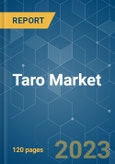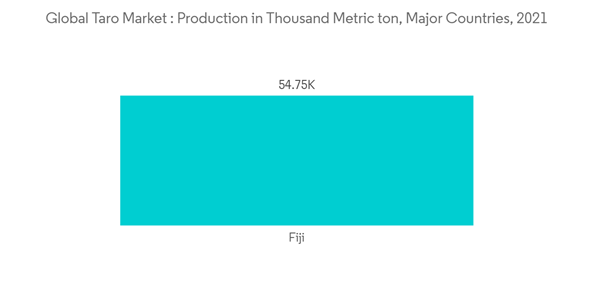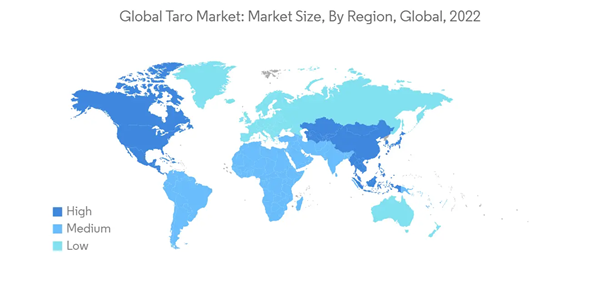The Global Taro Market is projected to register a CAGR of 3.5% during the forecast period.
According to FAOSTAT, taro production was 12.3 million ton which slightly declined compared to the previous year's production which is 12.6 million metric ton due to the pandemic effect in the world. During the same year, nearly 86.3% of global production was dominated by major producing countries such as China, Ecuador, Costa Rica, Fiji, and Indonesia in which China showed the highest production value compared to all countries with 1.9 million metric ton followed by Fiji. This will boost the taro market in the Asia region during the forecasting period.
In 2021, the United States imported taros worth USD 64,674 thousand, depicting 35.9% of the global imports. Ecuador, Mexico, and Costa Rica are the major exporting countries to the United States. According to ITC Trade, in 2021, Ecuador exported USD 35,309 thousand worth of taros to the United States, Mexico exported USD 9,021 thousand worth of taros, and the exports from Costa Rica were valued at USD 7,336 thousand.
Moreover, the high nutritional value of cocoyam could be explored in new markets in Europe and the United States of America to substitute for other vegetables, such as spinach. This is expected to lead to the market growth over the forecast period.
This product will be delivered within 2 business days.
Key Highlights
- Taro (Colocasia esculenta) is rich in carbohydrates and a good replacement for wheat flour. However, it is well-known to farmers for its ability to produce a reasonable yield in poor soil conditions with less or no farm inputs and often grown by resource-limited farmers, and is regarded as a good source of food security. Taro powder is also becoming popular, and this will boost the growth of the market in the coming years.
- Taro is the most widely cultivated species in the family Araceae, which is used as a vegetable. Countries such as the United States, Australia, Japan, and New Zealand are the key import market. Major producing countries are China, Ecuador, Costa Rica, Fiji, and Indonesia.
- Globally, North America is dominating taro imports. For instance, in 2021, the United States imported 35.7% of the total taro imports. Rising demand from North America and Asia-Pacific countries is driving taro production. In 2021, taro production was 12.3 million tons. This was which is slightly declined compared to the previous year's production which is 12.6 million metric ton due to the pandemic effect in the world.
Taro Market Trends
Strong Growth in Taro Production
Taro is a great source of carbohydrate used in infant weaning diets and low glycaemic index foods suitable for diabetics. Its tuber has starch molecules which are smaller than those of potato, corn and wheat and can be used in cosmetics and in pharmaceuticals as binders in tablets. Both corms and leaves contain good-quality protein and are good sources of phosphorus, potassium, calcium, and readily available iron. Moreover, the starch in taro’s tuber has the capacity to end the world’s plastic menace and it can be used to make plastic that degenerates over time. Due to its nutritional benefit and other industrial, the demand for the taro is increasing across the globe. To satisfy the rising demand, farmers are increasing the area cultivated under taro.According to FAOSTAT, taro production was 12.3 million ton which slightly declined compared to the previous year's production which is 12.6 million metric ton due to the pandemic effect in the world. During the same year, nearly 86.3% of global production was dominated by major producing countries such as China, Ecuador, Costa Rica, Fiji, and Indonesia in which China showed the highest production value compared to all countries with 1.9 million metric ton followed by Fiji. This will boost the taro market in the Asia region during the forecasting period.
North America Dominates the Global Imports
North America is the largest market for Taro which dominates globally due to the high consumer demand. In restaurants, Taro root is most commonly used to make chips and is a healthier alternative to corn or potato chips. According to ITC Trade, in 2021, Global import value was valued at USD 181,258 thousand, which increased by 21% compared to 2020. In 2021, the United States and Canada were among the major importing countries, and the United States is the largest importer of taro in the North American region.In 2021, the United States imported taros worth USD 64,674 thousand, depicting 35.9% of the global imports. Ecuador, Mexico, and Costa Rica are the major exporting countries to the United States. According to ITC Trade, in 2021, Ecuador exported USD 35,309 thousand worth of taros to the United States, Mexico exported USD 9,021 thousand worth of taros, and the exports from Costa Rica were valued at USD 7,336 thousand.
Moreover, the high nutritional value of cocoyam could be explored in new markets in Europe and the United States of America to substitute for other vegetables, such as spinach. This is expected to lead to the market growth over the forecast period.
Taro Industry Overview
Additional Benefits:
- The market estimate (ME) sheet in Excel format
- 3 months of analyst support
This product will be delivered within 2 business days.
Table of Contents
1 INTRODUCTION
4 MARKET DYNAMICS
5 MARKET SEGMENTATION
Methodology

LOADING...










